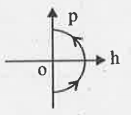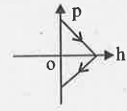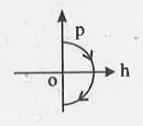A ball is thrown vertically up (taken as + z-axis) from the ground. The correct momentum-height (p-h) diagram is:




The correct Answer is:d
To solve the problem regarding the momentum-height (p-h) diagram for a ball thrown vertically upward, we will follow these steps:
Step 1: Understand the Motion of the Ball
When a ball is thrown vertically upward, it moves against the force of gravity. Initially, it has a certain velocity (u) and as it rises, its velocity decreases due to the acceleration due to gravity (g).
Hint: Remember that the velocity decreases as the ball rises until it reaches its maximum height, where the velocity becomes zero.
Step 2: Use the Equation of Motion
We can use the third equation of motion to relate velocity (v), initial velocity (u), acceleration (a), and height (h):
v2=u2−2gh
Here, we take acceleration due to gravity as negative since it acts downward.
Hint: The equation shows that as height (h) increases, the velocity (v) decreases.
Step 3: Relate Momentum to Velocity
Momentum (p) is given by:
p=mv
Where m is the mass of the ball. From the equation of motion, we can express velocity in terms of height:
v=√u2−2gh
Thus, the momentum can be expressed as:
p=m√u2−2gh
Hint: The momentum depends on the square root of the height, indicating a non-linear relationship.
Step 4: Analyze the Momentum-Height Relationship
As the ball rises:
- At ground level (h = 0), momentum is maximum (p = mu).
- As height increases, momentum decreases until it reaches zero at maximum height (h = h_max).
- After reaching maximum height, as the ball falls back down, momentum will become negative.
Hint: The graph will show a parabolic relationship, decreasing to zero at maximum height and then becoming negative as the ball descends.
Step 5: Determine the Correct Graph
From the options given:
- Options 2 and 3 are incorrect because they show linear relationships.
- Between options 1 and 4, we need to determine the direction of momentum:
- Option 1 suggests momentum starts negative and becomes positive.
- Option 4 suggests momentum starts positive and becomes negative.
Since the ball is thrown upwards, it starts with positive momentum and decreases to zero at maximum height, then becomes negative as it falls back down. Therefore, option 4 is correct.
Hint: Look for the graph that starts positive, decreases to zero, and then goes negative.
Final Answer
The correct momentum-height (p-h) diagram is represented by Option 4.
When a ball is thrown vertically upward, it moves against the force of gravity. Initially, it has a certain velocity (u) and as it rises, its velocity decreases due to the acceleration due to gravity (g).
We can use the third equation of motion to relate velocity (v), initial velocity (u), acceleration (a), and height (h):
v2=u2−2gh
Here, we take acceleration due to gravity as negative since it acts downward.
Momentum (p) is given by:
p=mv
Where m is the mass of the ball. From the equation of motion, we can express velocity in terms of height:
v=√u2−2gh
Thus, the momentum can be expressed as:
p=m√u2−2gh
As the ball rises:
- At ground level (h = 0), momentum is maximum (p = mu).
- As height increases, momentum decreases until it reaches zero at maximum height (h = h_max).
- After reaching maximum height, as the ball falls back down, momentum will become negative.
From the options given:
- Options 2 and 3 are incorrect because they show linear relationships.
- Between options 1 and 4, we need to determine the direction of momentum:
- Option 1 suggests momentum starts negative and becomes positive.
- Option 4 suggests momentum starts positive and becomes negative.
The correct momentum-height (p-h) diagram is represented by Option 4.
Topper's Solved these Questions
Similar Questions
Knowledge Check
- Question 1 - Select One
A ball is thrown vertically up (taken as + z-axis) from the ground. The correct momentum-height h diagram is:
A B
B C
C D
D
- Question 2 - Select One
A ball is thrown vertically upwards from the ground. It crosses a point at the height of 25 m twice at an interval of 4 secs. The ball was thrown with the velocity of
A20 m/secB25 m/secC30 m/secD35 m/sec - Question 3 - Select One
A ball is thrown vertically upwards from the ground. It crosses a point at the height of 25 m twice at an interval of 4 secs. The ball was thrown with the velocity of
A20m/secB25m/secC30m/secD35m/sec
A ball is thrown vertically upwards. What is its momentum at the highest point?
View SolutionAn open elevator is ascending with constant speed v=10m/s. A ball is thrown vertically up by a boy on the lift when he is at a height h=10m from the ground. The velocity of projection is v=30m/s with respect to elevator. Find
(a) the maximum height attained by the ball.
(b) the time taken by the ball to meet the elevator again.
(c) time taken by the ball to reach the ground after crossing the elevator.View SolutionA stone is thrown vertically up from the ground. It reaches a maximum height of 50 m in 10 sec. After what time it will reach the ground from maximum height position ?
View SolutionA ball is thrown vertically upwards from the ground. If T1 and T2 are the respective time taken in going up and coming down, and the air resistance is not ignored, then
View SolutionA body is thrown vertically up from the ground. It reaches a maximum height of 100 m in 5 sec . After what time it will reach the ground from the maximum height position
View Solution

